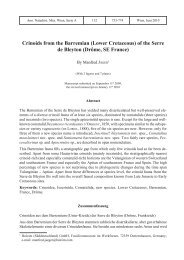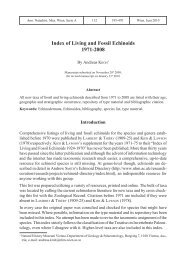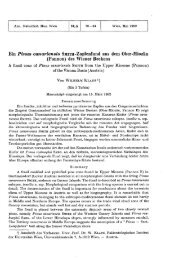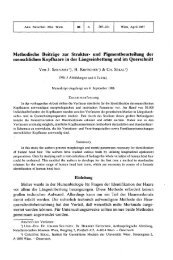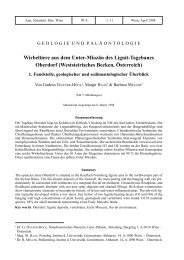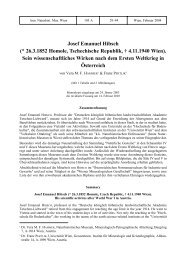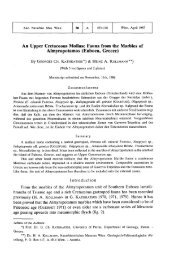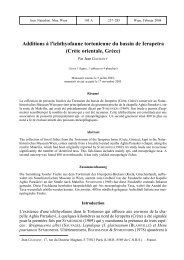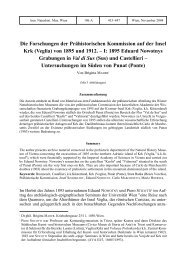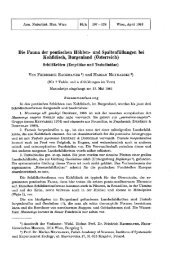ZEISS, A. (2001): Die Ammonitenfauna der Tithonklippen von ...
ZEISS, A. (2001): Die Ammonitenfauna der Tithonklippen von ...
ZEISS, A. (2001): Die Ammonitenfauna der Tithonklippen von ...
Create successful ePaper yourself
Turn your PDF publications into a flip-book with our unique Google optimized e-Paper software.
<strong>ZEISS</strong>, A. (<strong>2001</strong>): <strong>Die</strong> <strong>Ammonitenfauna</strong> <strong>der</strong> <strong>Tithonklippen</strong> <strong>von</strong> Ernstbrunn,<br />
Nie<strong>der</strong>österreich. Mit einem Beitrag <strong>von</strong> T. HOFMANN. – Neue Denkschriften<br />
des Naturhistorischen Museums in Wien, Band 6.<br />
75 Textseiten, 20 Tafeln, Großformat, Ganzleinen, Kunstdruckpapier. – Verlag Ferdinand<br />
Berger & Söhne, Wien - Horn. (Preis: € 35,– / ATS 490,–). – ISBN 3-85028-338-0.<br />
Soeben erschienen – in einer überaus gediegenen, durchaus bibliophil zu nennenden Ausgabe<br />
– ist die erste mo<strong>der</strong>ne Gesamtdarstellung <strong>der</strong> <strong>Ammonitenfauna</strong> <strong>von</strong> Ernstbrunn<br />
<strong>von</strong> Arnold <strong>ZEISS</strong>, Erlangen. Der routinierte Bearbeiter <strong>von</strong> Ammonitenfaunen aus dem<br />
Oberen Jura schließt damit eine europäische Kenntnislücke. Das reiche Fundmaterial aus<br />
<strong>der</strong> Klippenregion <strong>von</strong> Ernstbrunn ist durch jahrzehntelange Sammeltätigkeit Friedrich<br />
BACHMAYERs zustandegekornmen, dem das Werk in memoriam gewidmet ist. <strong>Die</strong> Arbeit<br />
umfaßt 38 Taxa, 8 da<strong>von</strong> sind neu. 50 % <strong>der</strong> insgesamt etwa 250 Exemplare sind Perisphinctaceae,<br />
25 % Lytocerataceae, je 12,5 % sind Phyllocerataceae und Haplocerataceae.<br />
Der hervorragende Erhaltungszustand des Materials erlaubte systematische, paläobiologische,<br />
phylogenetische und paläobiogeographische Schlußfolgerungen. So konnte<br />
bei fast allen taxonomischen Einheiten Dimorphismus nachgewiesen werden. <strong>Die</strong> Fauna<br />
wurde vom Autor ins mittlere Mitteltithonium bis untere Obertithonium eingestuft. Ein<br />
Beitrag <strong>von</strong> Th. HOFMANN zur regionalen Stellung des Ernstbrunner Kalkes und zur<br />
Erforschungsgeschichte rundet die Arbeit sinnvoll ab.<br />
H. SUMMESBERGER<br />
SCHULTZ, O. (<strong>2001</strong>): Bivalvia neogenica (Nuculacea-Unionacea), Band 1 /<br />
Teil 1 – Catalogus Fossilium Austriae, ein Verzeichnis aller auf österreichischem<br />
Gebiet festgestellten Fossilien<br />
1 Tabelle, XLVIII + 379 Seiten, 8 Abbildungen,<br />
56 Tafeln. – Wien (Verlag <strong>der</strong><br />
Österreichischen Akademie <strong>der</strong> Wissenschaften).<br />
– ISBN 3-7001-2982-3.<br />
The diverse and generally well preserved<br />
Mollusc fauna of the Vienna Basin and the<br />
Molasse Basin of Austria is among the<br />
most famous Neogene faunas of Europe.<br />
First studies of the bivalves date back to the<br />
late 18th century (e.g. BORN, 1778; WALCH,<br />
1768). During the early 19th century, the<br />
knowledge on the inventory of fossil species<br />
has improved rapidly through numerous<br />
geognostic works by PREVOST, CZJZEK,<br />
PARTSCH, and many others. These efforts<br />
culminated in the monograph of HÖRNES<br />
(1859-1867) and REUSS (1870) which<br />
determined the state-of-art for the century.<br />
In the following 130 years, hundreds of<br />
contributions completed the spectrum.
Only a taxonomic revision of the recordings could put or<strong>der</strong> into the obscured taxonomy<br />
and stratigraphic distribution.<br />
SCHULTZ attempts successfully, to provide full information on all Neogene bivalves from<br />
Austria published up to the year 2000. The large list of references documents a good<br />
portion of bibliophily. The dimensions of the work required a splitting of the results into<br />
three parts: This first volume contains all taxa from the Nuculacea through Unionacea.<br />
It follows the systematic arrangement by COX & al. 1969 & 1971. More than 280 taxa<br />
are discussed; the emphasis lies on the Miocene species but also Late Oligocene bivalves<br />
are included.<br />
Because of the large number, not all recordings could be checked and revised critically.<br />
Doubtful recordings are indicated by questionmarks. However, the author comments<br />
critically on the references in the remarks to each taxon. Of great importance for future<br />
research are the outstandingly accurate distribution data, Besides Austria, the author<br />
integrales references from all European bioprovinces and thus provides the key data for<br />
biogeographic analyses. Hopefully, the correlation with the standard scale will extinguish<br />
the still persisting confusion in the literature caused by HÖRNES (1859-1867), who<br />
erroneously correlated the Middle Miocene Paratethys faunas with those of the<br />
Tortonian.<br />
The concise text and the beautiful plates will certainly be a solid basis for further systematic<br />
and taxonomy studies on European Neogene bivalves. As the current state-of-theart,<br />
the "Bivalvia neogenica" are a must for paleontology libraries.<br />
M. HARZHAUSER



